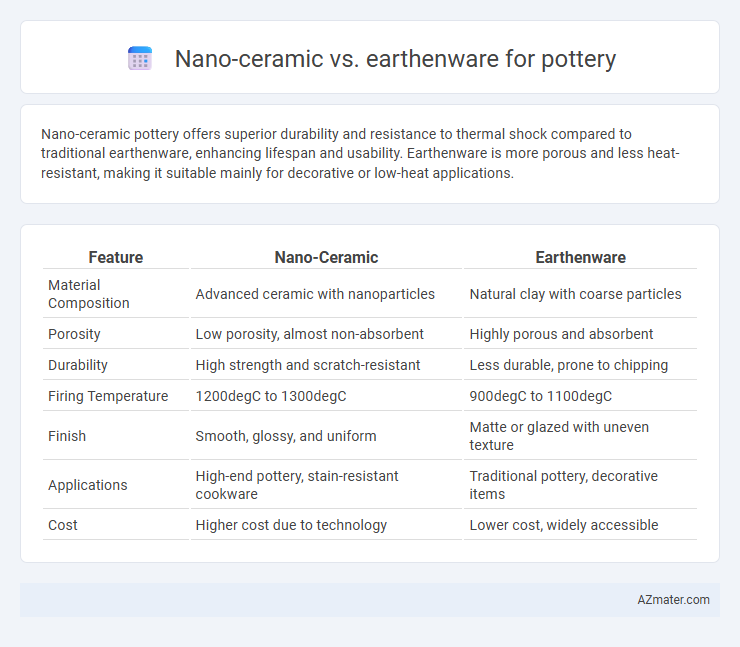Nano-ceramic pottery offers superior durability and resistance to thermal shock compared to traditional earthenware, enhancing lifespan and usability. Earthenware is more porous and less heat-resistant, making it suitable mainly for decorative or low-heat applications.
Table of Comparison
| Feature | Nano-Ceramic | Earthenware |
|---|---|---|
| Material Composition | Advanced ceramic with nanoparticles | Natural clay with coarse particles |
| Porosity | Low porosity, almost non-absorbent | Highly porous and absorbent |
| Durability | High strength and scratch-resistant | Less durable, prone to chipping |
| Firing Temperature | 1200degC to 1300degC | 900degC to 1100degC |
| Finish | Smooth, glossy, and uniform | Matte or glazed with uneven texture |
| Applications | High-end pottery, stain-resistant cookware | Traditional pottery, decorative items |
| Cost | Higher cost due to technology | Lower cost, widely accessible |
Introduction to Nano-ceramic and Earthenware Pottery
Nano-ceramic pottery utilizes advanced nanotechnology to enhance the strength, durability, and heat resistance of ceramic materials, resulting in finer, more resilient pottery pieces. Earthenware pottery, made from natural clay fired at lower temperatures, offers a porous and rustic finish traditionally used for decorative and functional items. Comparison of these materials highlights nano-ceramic's superior performance in modern applications versus the classic aesthetic and affordability of earthenware.
Material Composition: Nano-ceramic vs Earthenware
Nano-ceramic pottery features a composition of nanometer-sized ceramic particles, enhancing its strength, durability, and resistance to thermal shock compared to traditional earthenware. Earthenware is made from natural clay fired at lower temperatures (typically between 1,000degC and 1,150degC), resulting in a porous, less dense material that requires glazing to be waterproof and more fragile. The advanced nano-ceramic materials provide superior mechanical properties and a smoother surface finish, distinguishing them significantly from conventional earthenware's coarser texture and limited structural resilience.
Durability and Strength Differences
Nano-ceramic pottery exhibits superior durability and strength compared to traditional earthenware due to its advanced nanomaterial composition, which enhances resistance to chipping and cracking. Earthenware, being porous and fired at lower temperatures, tends to be more fragile and prone to damage under impact or heavy use. The nano-ceramic's dense microstructure also provides better thermal shock resistance, making it ideal for both decorative and functional pottery applications requiring long-lasting performance.
Heat Resistance and Thermal Properties
Nano-ceramic pottery exhibits superior heat resistance compared to traditional earthenware, withstanding higher temperatures without cracking or deforming. Its advanced thermal properties allow for even heat distribution and retention, making it ideal for cooking applications that require rapid temperature changes. Earthenware, while aesthetically appealing, has a lower thermal tolerance and is more prone to thermal shock during intense heat exposure.
Aesthetic Qualities and Surface Finishes
Nano-ceramic pottery offers a sleek, glossy finish with enhanced color vibrancy and durability, maintaining a smooth, modern aesthetic that resists scratches and stains. Earthenware, by contrast, features a warm, rustic appeal characterized by its porous surface and matte or semi-gloss glazes that highlight natural textures and handcrafted imperfections. The surface finish of nano-ceramics tends to be more uniform and reflective, while earthenware emphasizes organic, tactile qualities that age gracefully over time.
Porosity and Water Absorption Rates
Nano-ceramic pottery exhibits significantly lower porosity and water absorption rates compared to traditional earthenware, making it more durable and less prone to water damage. The advanced nanomaterial composition of nano-ceramics creates a denser microstructure that effectively seals pores, enhancing resistance to moisture penetration. In contrast, earthenware's higher porosity results in greater water absorption, requiring glazing or sealing to prevent fragility and staining.
Applications in Modern and Traditional Pottery
Nano-ceramic materials offer superior durability, heat resistance, and enhanced surface smoothness, making them ideal for modern pottery applications such as dishwasher-safe kitchenware and decorative items with intricate designs. Earthenware, characterized by its porous nature and rustic texture, remains favored in traditional pottery for its natural aesthetic and suitability for hand-crafted items like flowerpots, cookware, and cultural artifacts. Both materials serve distinct roles in pottery, with nano-ceramics pushing technological innovations while earthenware preserves artisanal heritage.
Sustainability and Environmental Impact
Nano-ceramic pottery offers enhanced durability and lower porosity compared to traditional earthenware, reducing the need for frequent replacement and conserving resources. Earthenware, often made from locally sourced clays, has a lower firing temperature, resulting in reduced energy consumption during production. Both materials present eco-friendly qualities, but nano-ceramics' advanced formulation supports longer life cycles, contributing to sustainability through decreased material waste.
Cost and Accessibility Comparison
Nano-ceramic pottery typically incurs higher production costs due to advanced materials and technology, making it less accessible for hobbyists and small-scale artisans. Earthenware, composed of natural clay fired at lower temperatures, is more affordable and widely available, serving as the preferred choice for beginners and large-scale production. The cost-effectiveness and ease of sourcing earthenware materials contribute to its sustained popularity in pottery markets worldwide.
Choosing the Right Material for Your Pottery Needs
Nano-ceramic pottery offers superior durability, higher resistance to thermal shock, and a smoother, non-porous surface compared to traditional earthenware, making it ideal for functional and decorative pieces that require longevity and easy maintenance. Earthenware, favored for its rustic aesthetic and affordability, is more porous and less durable but excels in applications where breathability is important, such as planters and traditional crafts. Selecting between nano-ceramic and earthenware depends on your specific pottery needs, prioritizing factors like strength, finish quality, and intended use.

Infographic: Nano-ceramic vs Earthenware for Pottery
 azmater.com
azmater.com